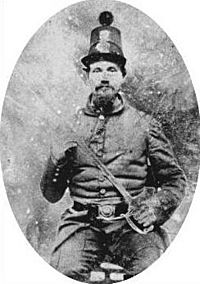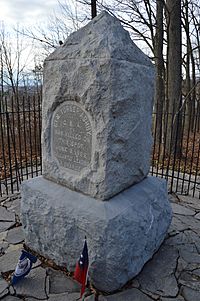Turner Ashby facts for kids
Quick facts for kids
Turner Ashby Jr.
|
|
|---|---|
 |
|
| Nickname(s) | "Black Knight of the Confederacy" |
| Born | October 23, 1828 Fauquier County, Virginia, U.S |
| Died | June 6, 1862 (aged 33) Harrisonburg, Virginia |
| Place of burial |
Stonewall Cemetery, Winchester, Virginia
|
| Allegiance | |
| Service/ |
|
| Years of service | 1861–62 |
| Rank | |
| Commands held | |
| Battles/wars | American Civil War |
Turner Ashby Jr. (born October 23, 1828 – died June 6, 1862) was an important officer during the American Civil War. He was a Confederate cavalry commander, known for his skill with horses. People sometimes called him the "Black Knight of the Confederacy."
When he was young, Ashby started a group of horse riders called the Mountain Rangers. This group later became part of the 7th Virginia Cavalry. When the Civil War began, Ashby and his riders joined Colonel Thomas J. "Stonewall" Jackson's command. Ashby's scouting and quick movements helped Jackson a lot during his campaigns. Sadly, Ashby was killed while leading his men in battle near Harrisonburg. He had just been promoted to general, but his promotion was not officially confirmed until after his death.
Contents
Turner Ashby's Early Life
Turner Ashby Jr. was born on a farm called Rose Bank Plantation in Fauquier County, Virginia. As a child, he loved playing near Goose Creek. He even had a pet wolf named Lupus!
His father died when Turner was young. His mother hired a tutor for him and his brother. Later, he went to a school nearby. But Turner liked exploring the countryside more than sitting in classes. He grew up to be an amazing horseman. He often won horse riding contests, sometimes even riding without a saddle or bridle!
Ashby also ran a mill on his family's property for a while. He was pretty good at both business and farming.
Joining the Virginia Militia
Turner Ashby's family had a history of serving in the military. His father was a colonel in the War of 1812, and his grandfather was a captain in the American Revolutionary War. Following in their footsteps, Ashby formed a group of horsemen in his twenties. They were called the "Mountain Rangers."
This group first helped keep order among workers on the Manassas Gap Railroad. When John Brown raided Harpers Ferry, the Mountain Rangers went there to help. They guarded Charles Town during Brown's trial. This is when Ashby's group officially joined the Virginia Militia.
Ashby was interested in politics but didn't win elections. Even though he didn't support Virginia leaving the United States at first, he decided to fight for his home state when it did. His Mountain Rangers became Company A of the 7th Virginia Cavalry. This unit was also known as "Ashby's Brigade." Ashby tried to capture the federal arsenal at Harpers Ferry, but U.S. forces burned most of the weapons before he could get there.
Ashby in the Civil War
At Harpers Ferry, Ashby worked with Colonel Thomas J. "Stonewall" Jackson. Ashby's job was to guard river crossings and bridges. He was known for riding long distances to check on his guards. He also helped people who supported the Confederacy move into Virginia. His men also caused problems for Union railroads and canals.
In June 1861, Ashby's brother, Richard, was killed in a fight with Union soldiers. This made Ashby very determined to fight against the Union forces.
In July 1861, Ashby was promoted to lieutenant colonel of the 7th Virginia Cavalry. Because his commander was sick, Ashby ended up leading half of the regiment. He even created the first Confederate horse artillery, called Chew's Battery. Ashby's cavalry helped screen the movement of General Joseph E. Johnston's army to the Manassas area. This allowed Johnston's troops to move without being stopped by Union forces. In October 1861, Ashby led an attack on Harpers Ferry, but Union forces won this battle.
By spring 1862, the 7th Virginia Cavalry had grown very large. It had 27 companies, which was much bigger than a normal regiment. Ashby was very busy patrolling, but his men were not always well-trained. Stonewall Jackson tried to take some of Ashby's cavalry away, but Ashby threatened to quit. Jackson changed his mind. Jackson also didn't want Ashby to be promoted to general because of his informal training. However, Ashby was promoted to brigadier general on May 23, 1862. He received his general's star in a ceremony in Winchester, Virginia.
Ashby's scouting and quick movements were very important to Jackson's success in the Valley campaign of 1862. However, Ashby sometimes made mistakes. At the First Battle of Kernstown, Jackson attacked a Union column that Ashby thought was small. But it turned out to be a huge force of 9,000 men, and Jackson had to retreat. Also, at the First Battle of Winchester, Ashby's men were busy taking supplies from captured wagons instead of stopping the retreating Union army.
As Jackson's army moved away from Union forces near Harrisonburg, Ashby was in charge of guarding the rear. On June 6, 1862, near Harrisonburg, Union cavalry attacked Ashby's position. Ashby's horse was shot, and he continued fighting on foot. He was then shot through the heart and died. His last words were "Charge, men! For God's sake. Charge!"
He had been appointed brigadier general only two weeks before he died. Even though he is often called a general, his promotion was never officially confirmed by the Confederate Senate.
Ashby's Legacy
Stonewall Jackson wrote about Ashby after his death:
As a partisan officer I never knew his superior; his daring was proverbial; his powers of endurance almost incredible; his tone of character heroic, and his sagacity almost intuitive in divining the purposes and movements of the enemy.
Ashby was first buried at the University of Virginia Cemetery. But in 1866, his body was moved to the Stonewall Cemetery in Winchester, Virginia. He was buried next to his younger brother, Richard. The Turner Ashby Monument stands in Harrisonburg, Virginia, at the place where he was killed.
A book about Ashby's life, called Life of Turner Ashby, was published in 1914.
Turner Ashby High School, in Bridgewater, Virginia, is named after him.
See also




